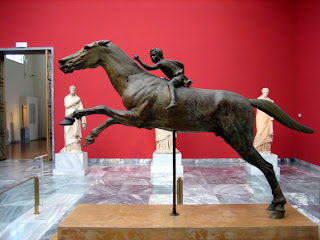MODERN ART - CUBISM
Cubism was one of the revolutionary art styles of the 20th century. It began around 1907 with Pablo Picasso’s painting titled Demoiselles D’Avignon which included elements of cubist style. The name ‘cubism’ derived from a comment made by a critic named Louis Vauxcelles who described Georges Braque's paintings as reducing everything to ‘geometric outlines, to cubes’. Cubism artists aimed to show different viewpoints at the same time and within the same space by breaking objects and figures down into distinct areas or planes and so suggest their three dimensional form. In doing so they were emphasizing the two-dimensional flatness of the canvas instead of creating the illusion of depth.
The Cubists saw the constraints of perspective as a challenge to advance. The fact that a picture drawn in perspentive could work from only one point of view limits their choices. As the picture was drawn from a settled position, the outcome looked frozen , like a snapshot, but the Cubists wanted to make pictures that came to past the unbending geometry of perspective. They needed to present the possibility of 'relativity' - how the artists saw and chose components from the subject, combining both their observations and memories into the one concentrated picture.
The Weeping Woman (1937) is an oil painting on canvas by Pablo Picasso executed in the style of analytical Cubism. It remains an iconic example of Spanish painting, and represents a continuation of the artist's anti-war theme instigated by his mural Guernica (1937, Reina Sofia, Madrid), which was his response to the terror-bombing of civilians during the Spanish Civil War. The model in the painting was the stunningly attractive professional photographer Dora Maar who was one of the leading surrealist artists of the 1930s. After meeting Picasso in Paris, in 1936, she became his mistress, muse, and intellectual companion.
"Weeping Woman" depicts an anguished, sobbing female, who holds a handkerchief up to her face to catch her copious tears. This universal image of suffering is painted in the flattened style of Picasso's early analytical Cubism, characterized by the use of angular and overlapping fragments of the subject's face, as if it were painted from different viewpoints simultaneously. In order to emphasize the two-dimensional nature of the work, Picasso makes no attempt to create 'depth' in the painting, by the use of linear perspective or any type of modelling/shading like chiaroscuro.
The most obvious meaning of the "Weeping Woman", when interpreted against the background of the ongoing civil war in Spain, is fairly straightforward. Formally dressed, as though at a funeral or other place of mourning, she represents the harrowing grief experienced by mothers, sisters and others, following the death of a loved one, especially during wartime.
The Cubists saw the constraints of perspective as a challenge to advance. The fact that a picture drawn in perspentive could work from only one point of view limits their choices. As the picture was drawn from a settled position, the outcome looked frozen , like a snapshot, but the Cubists wanted to make pictures that came to past the unbending geometry of perspective. They needed to present the possibility of 'relativity' - how the artists saw and chose components from the subject, combining both their observations and memories into the one concentrated picture.
The Weeping Woman
1937
By Pablo Picasso
The Weeping Woman (1937) is an oil painting on canvas by Pablo Picasso executed in the style of analytical Cubism. It remains an iconic example of Spanish painting, and represents a continuation of the artist's anti-war theme instigated by his mural Guernica (1937, Reina Sofia, Madrid), which was his response to the terror-bombing of civilians during the Spanish Civil War. The model in the painting was the stunningly attractive professional photographer Dora Maar who was one of the leading surrealist artists of the 1930s. After meeting Picasso in Paris, in 1936, she became his mistress, muse, and intellectual companion.
"Weeping Woman" depicts an anguished, sobbing female, who holds a handkerchief up to her face to catch her copious tears. This universal image of suffering is painted in the flattened style of Picasso's early analytical Cubism, characterized by the use of angular and overlapping fragments of the subject's face, as if it were painted from different viewpoints simultaneously. In order to emphasize the two-dimensional nature of the work, Picasso makes no attempt to create 'depth' in the painting, by the use of linear perspective or any type of modelling/shading like chiaroscuro.
The most obvious meaning of the "Weeping Woman", when interpreted against the background of the ongoing civil war in Spain, is fairly straightforward. Formally dressed, as though at a funeral or other place of mourning, she represents the harrowing grief experienced by mothers, sisters and others, following the death of a loved one, especially during wartime.




Interesting blog, it reminds me of Picasso Museum. He was famous a Spanish painter, sculptor, regarded as one of the most influential artists of the 20th century.
ReplyDeleteIf you like please leave comment and Follow the blog in. I tried to write a blog about it, hope you also like it in https://stenote.blogspot.com/2021/02/paris-at-picasso-museum.html.